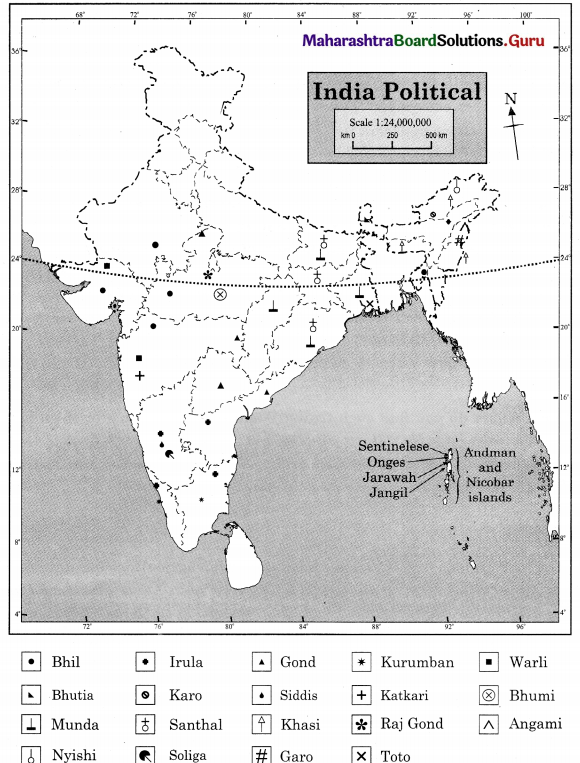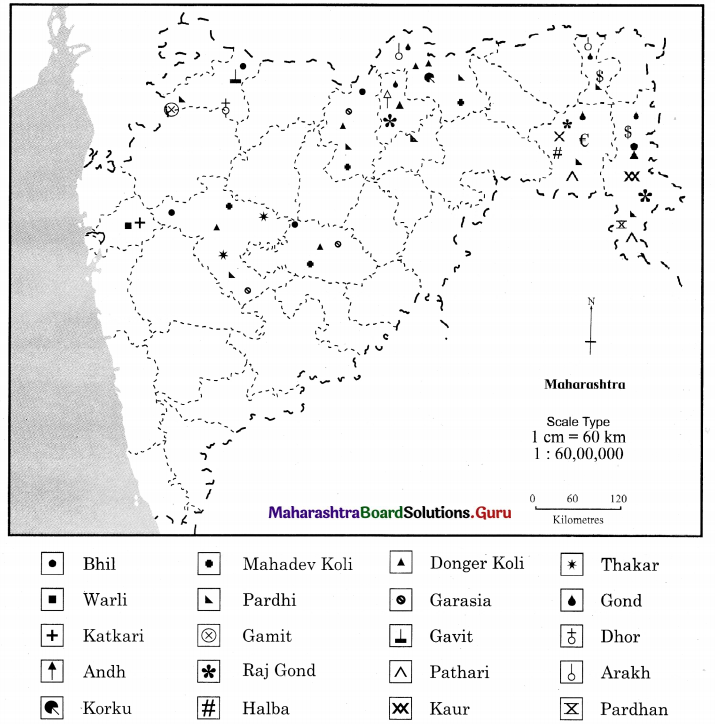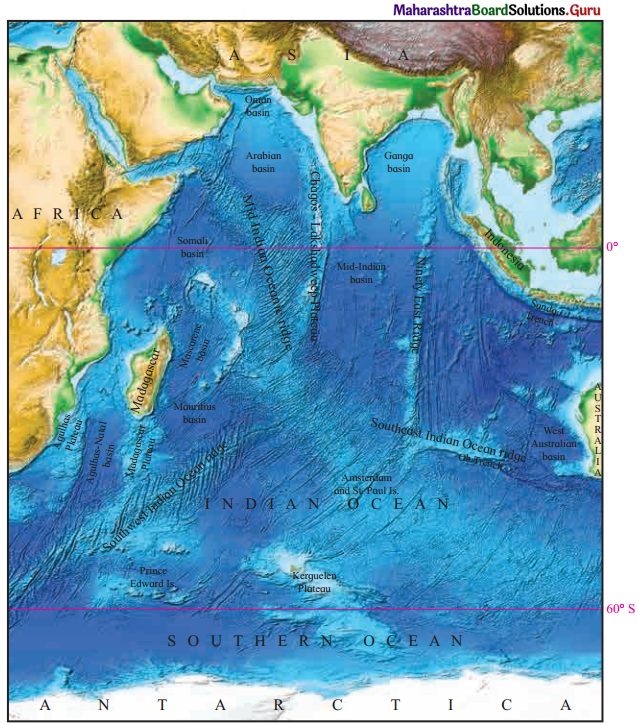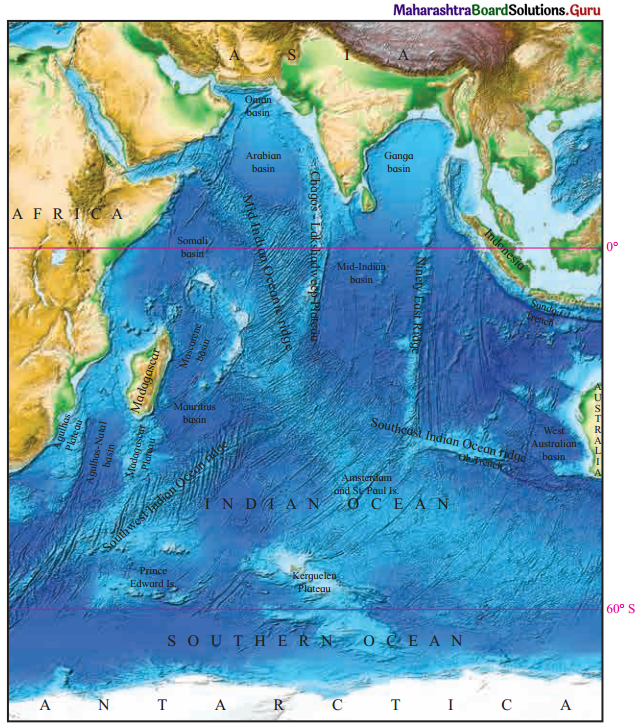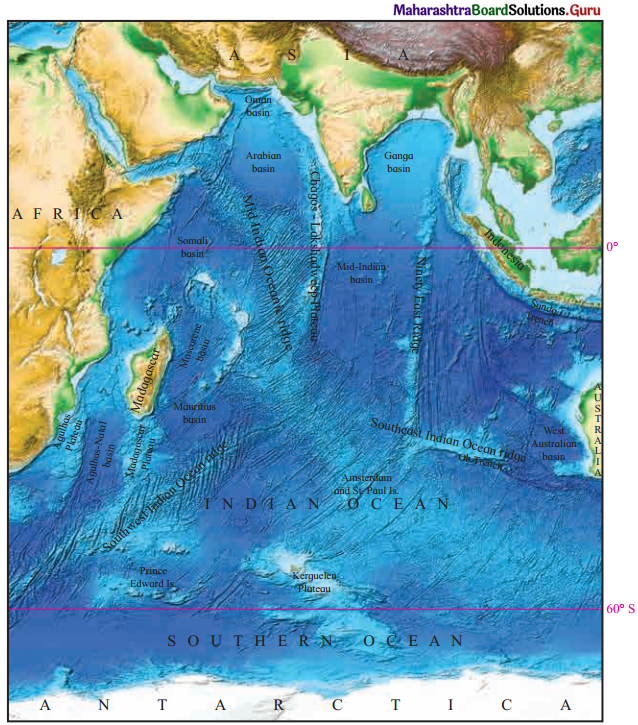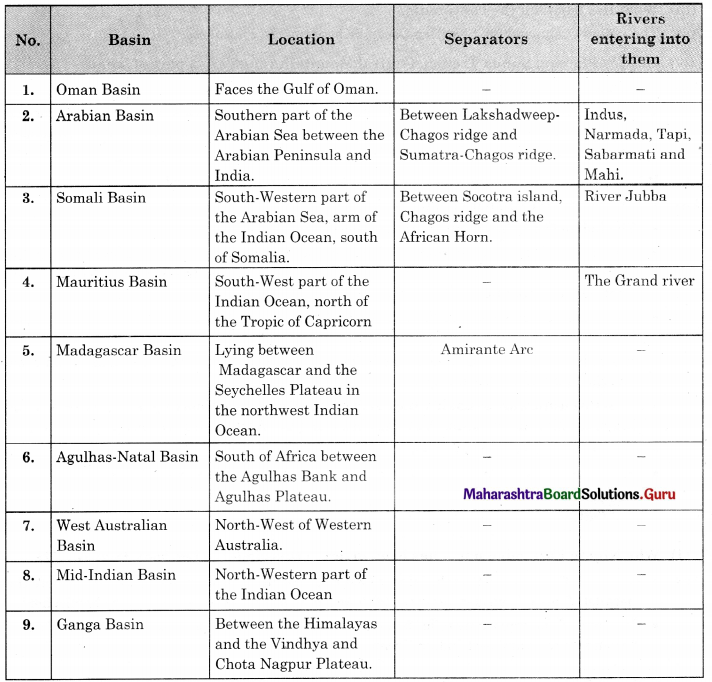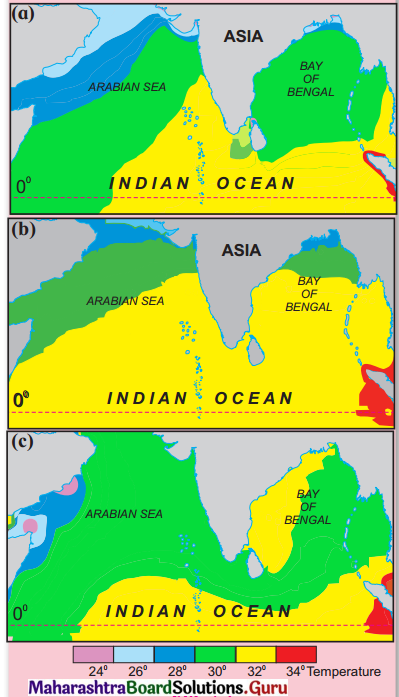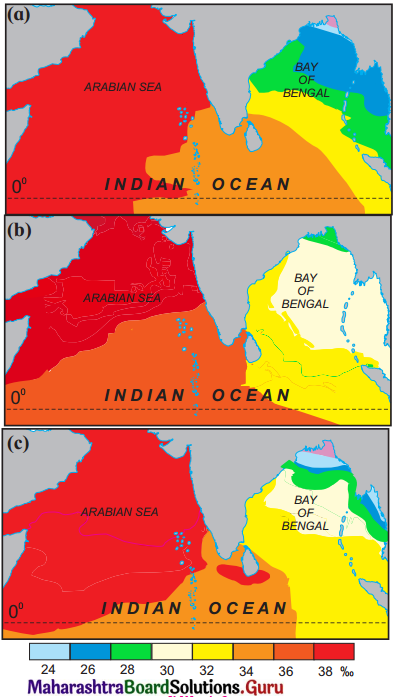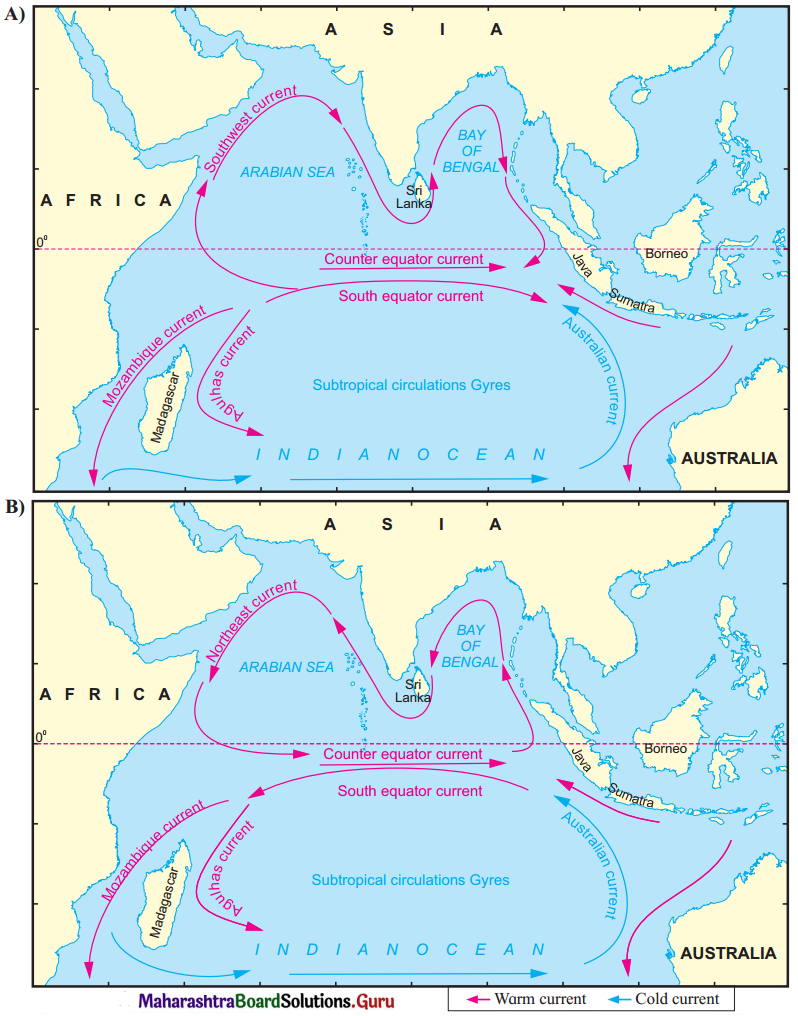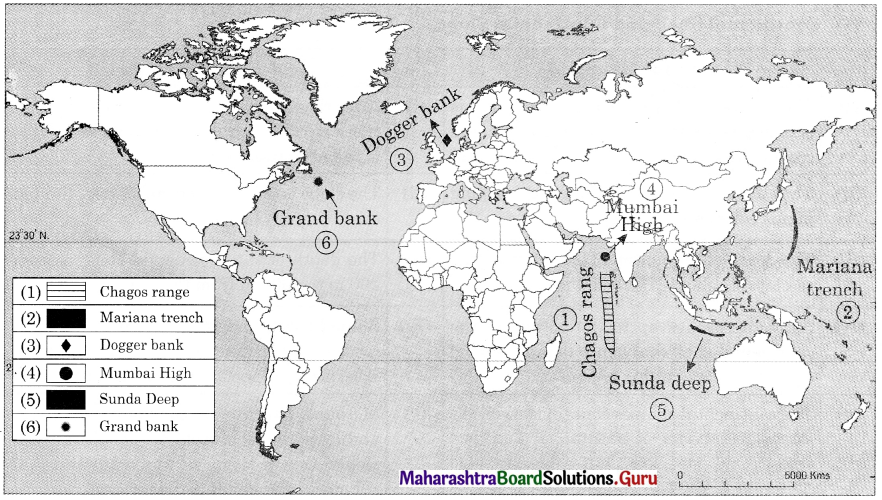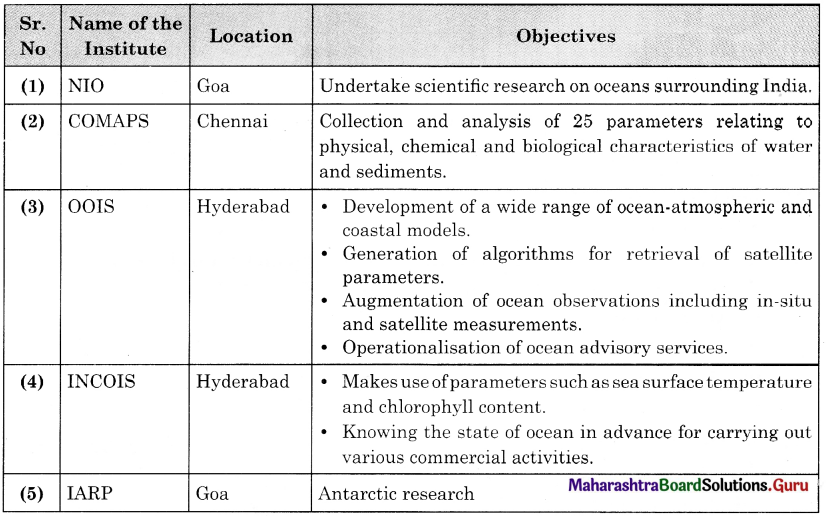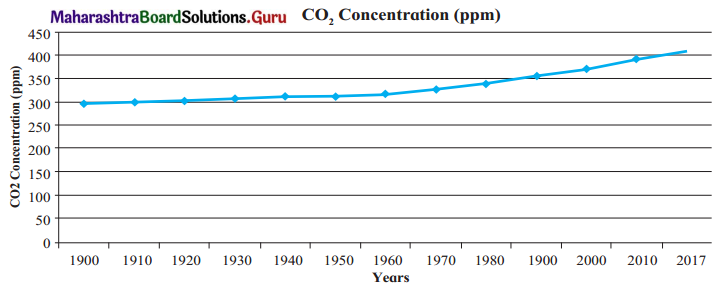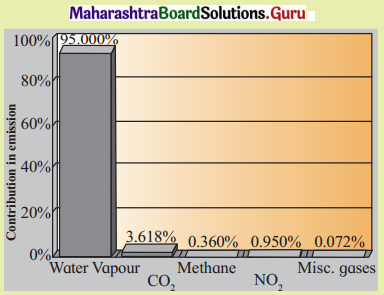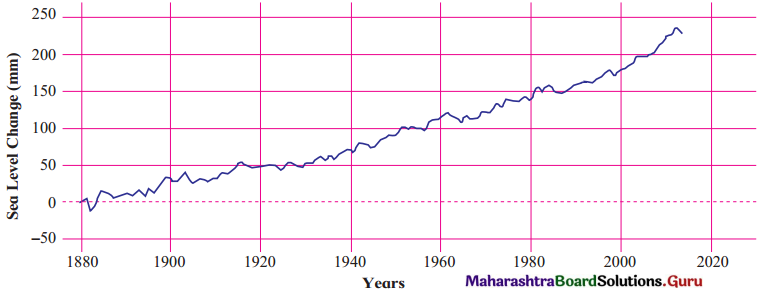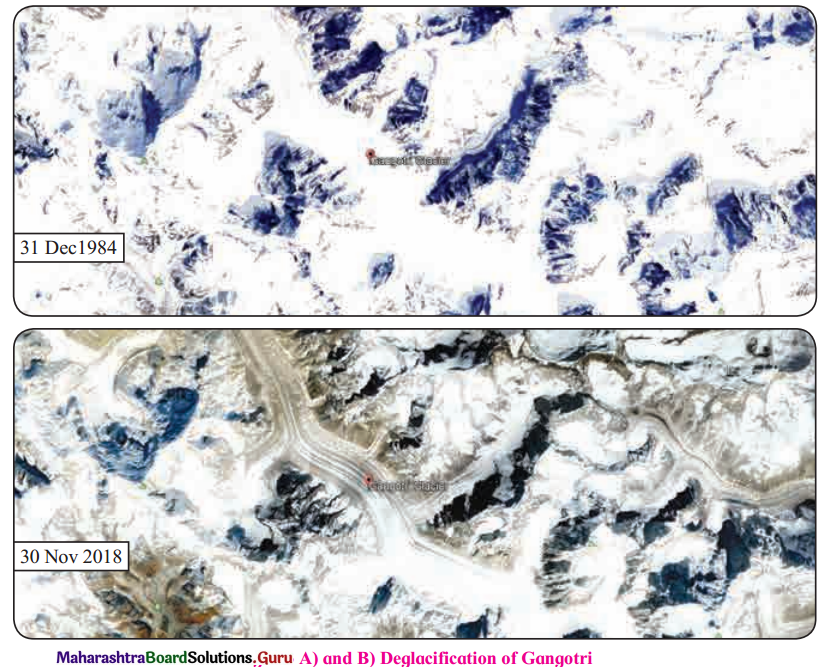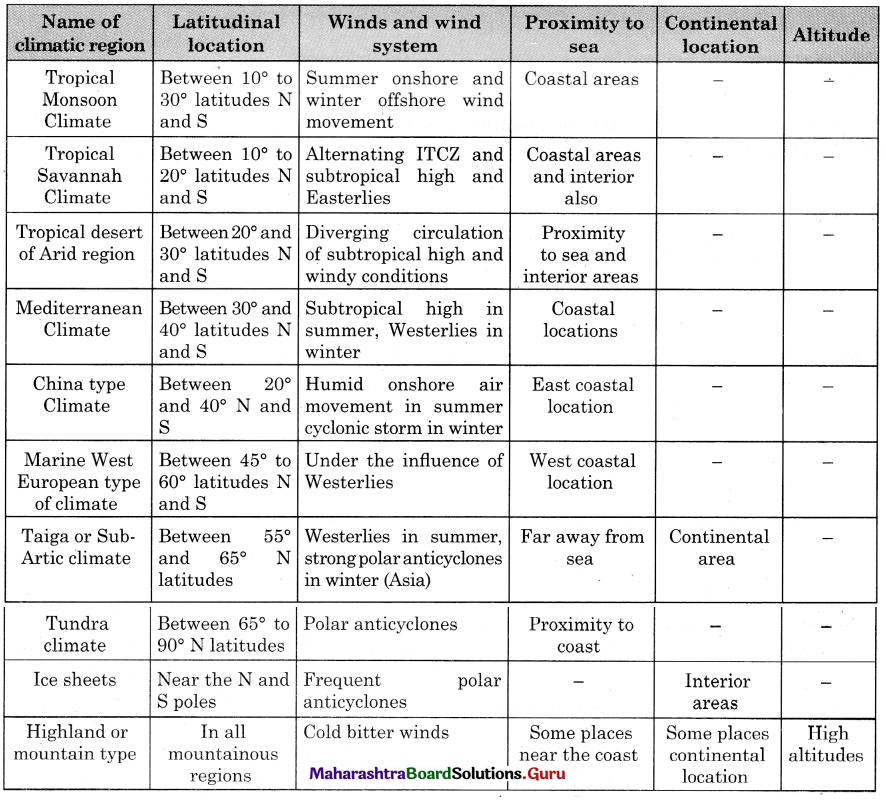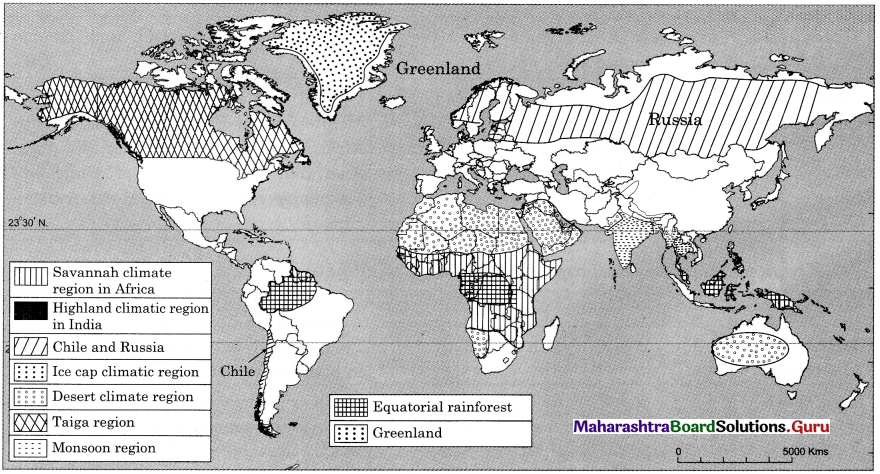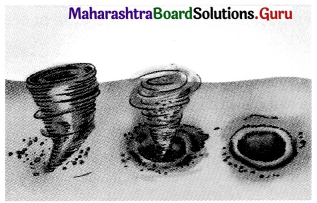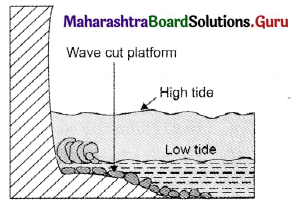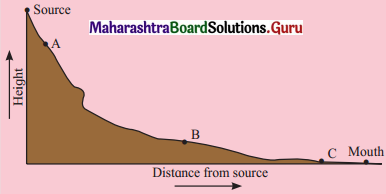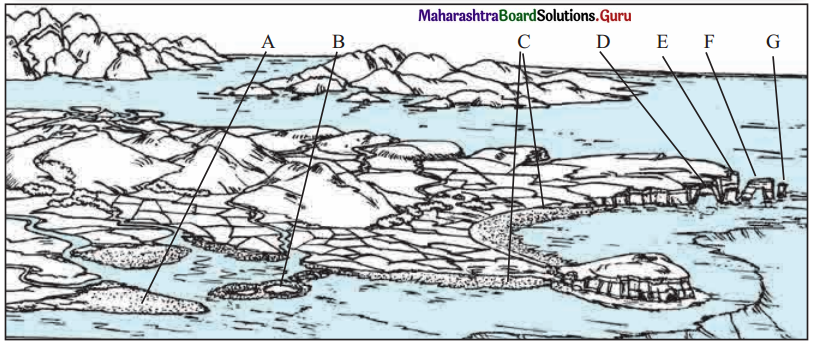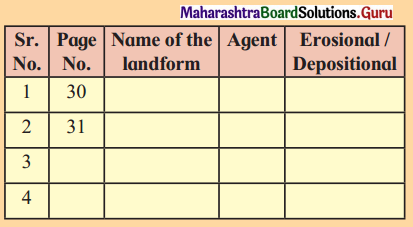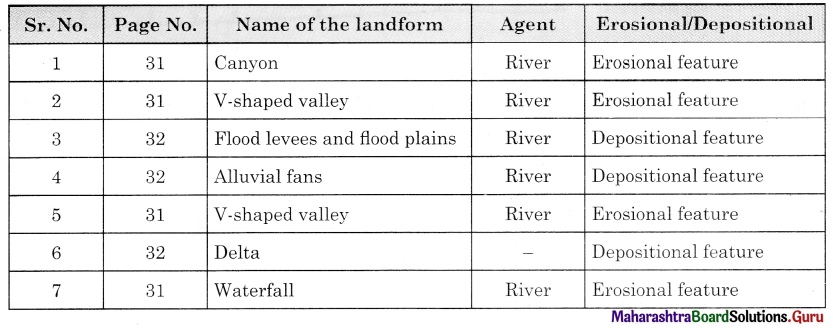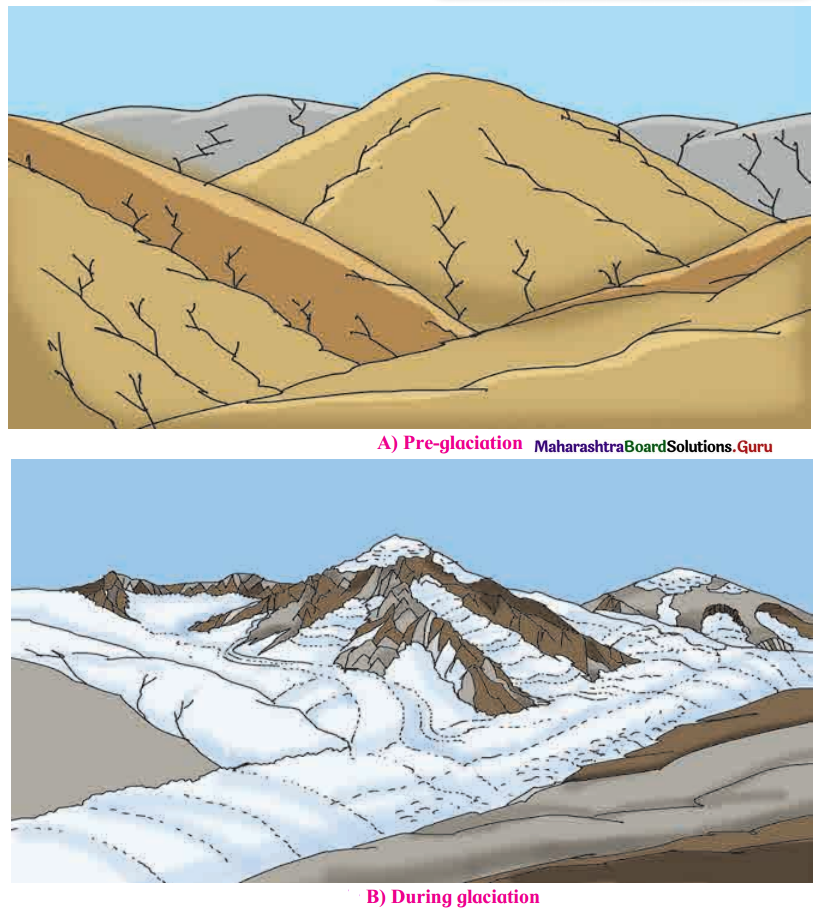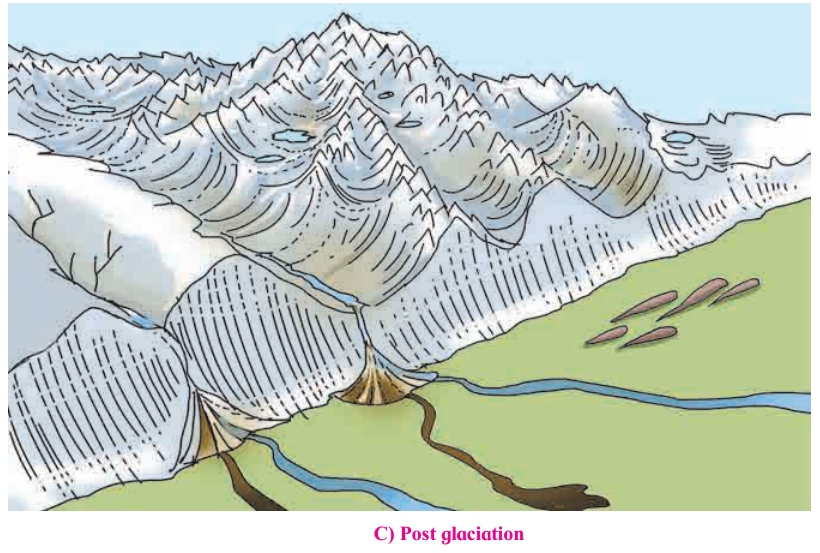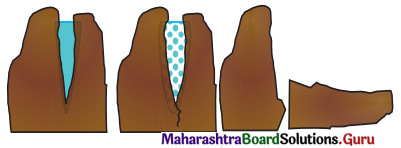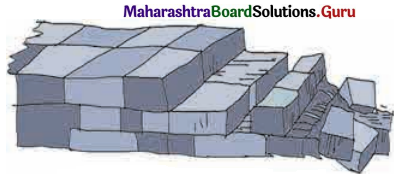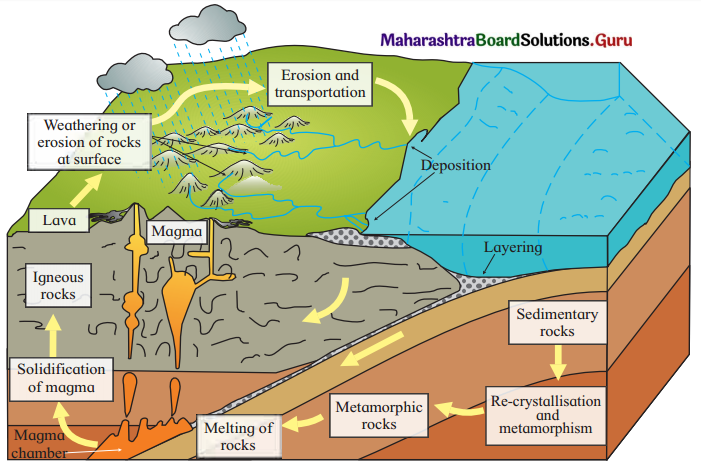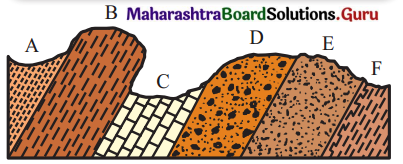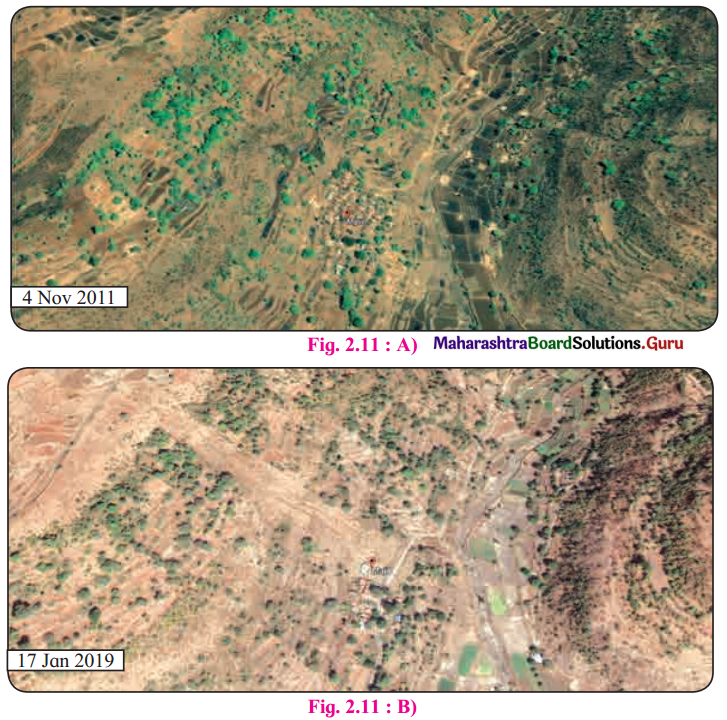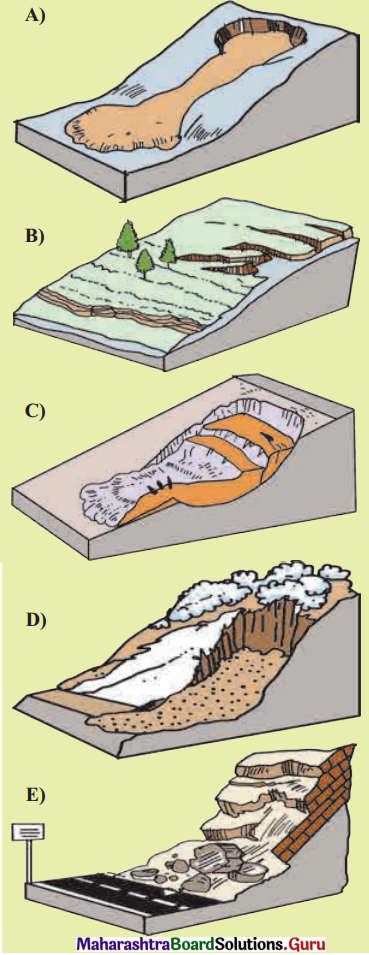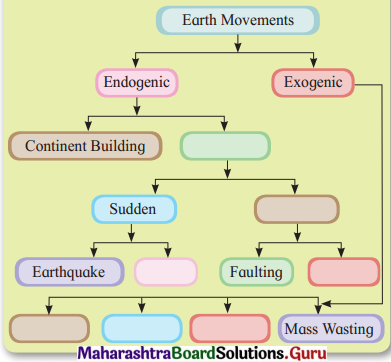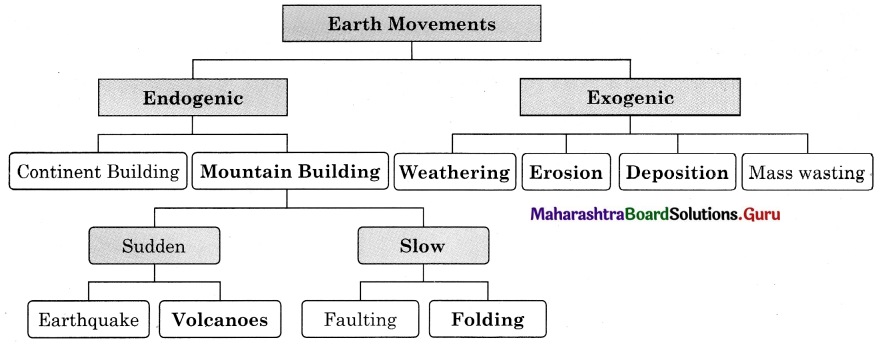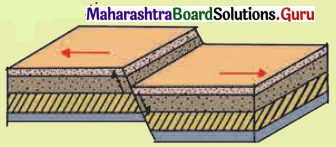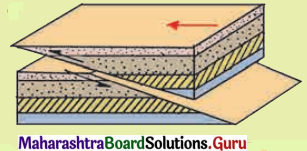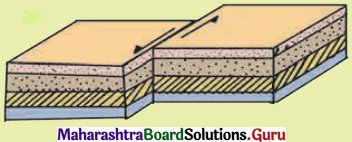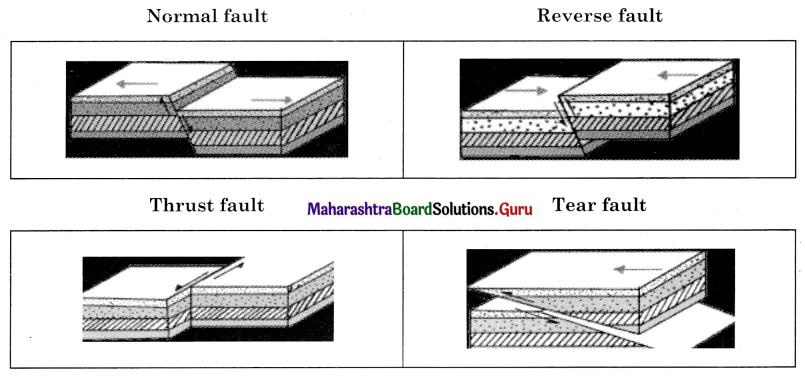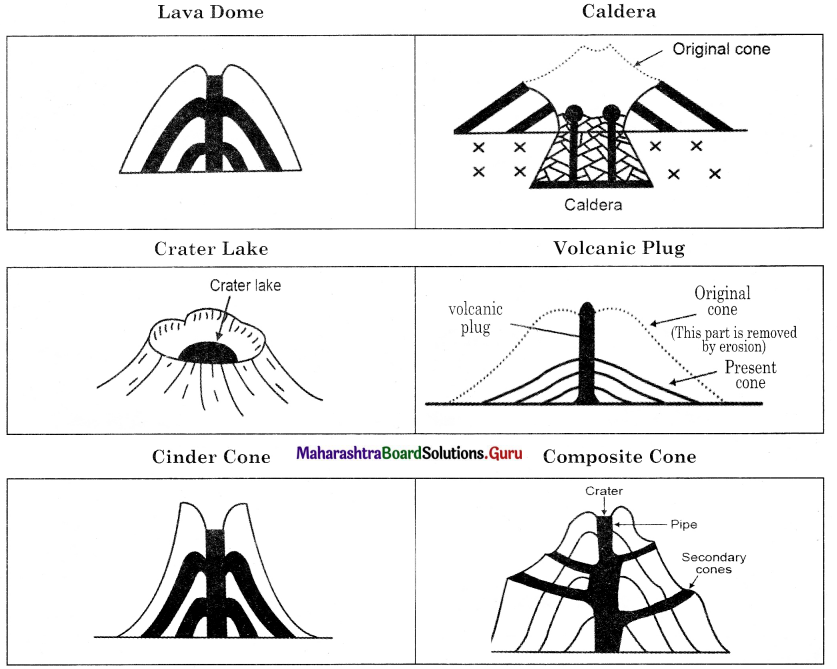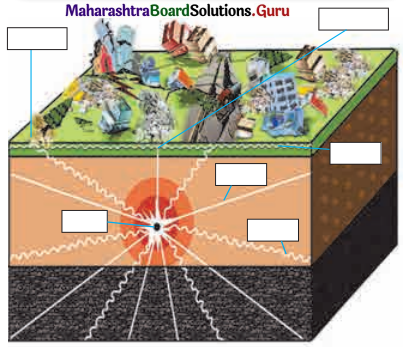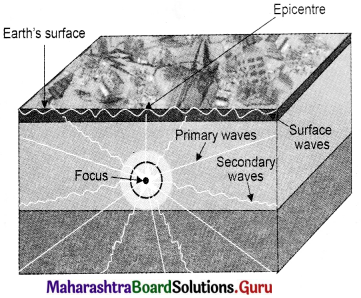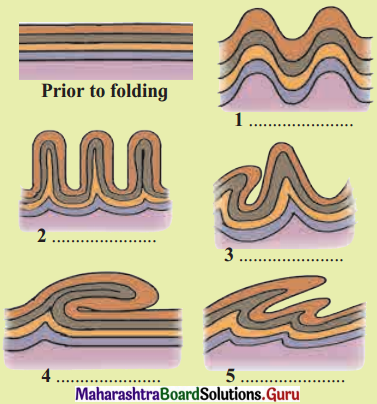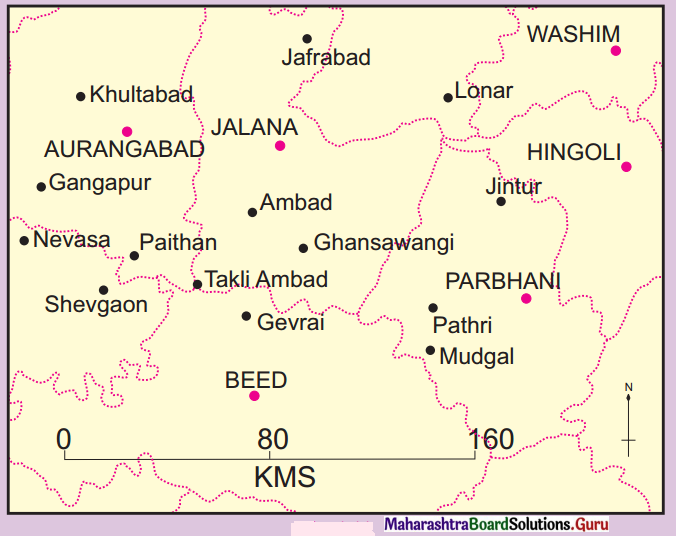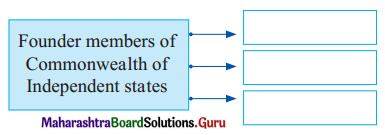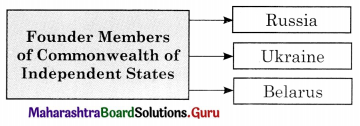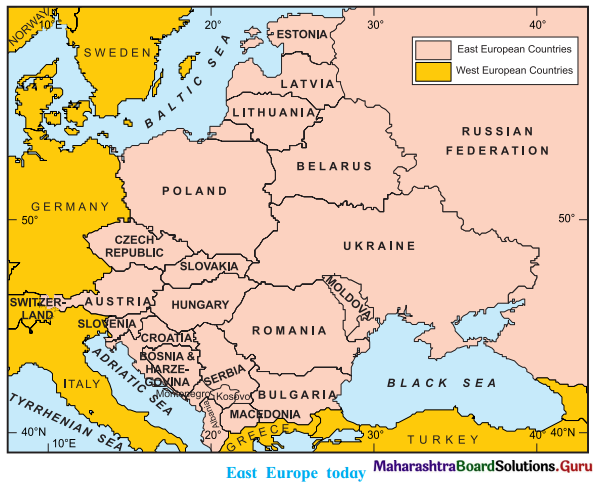Std 11 Geography Chapter 9 Question Answer Disaster Management Maharashtra Board
Balbharti Maharashtra State Board Class 11 Geography Solutions Chapter 9 Disaster Management Textbook Exercise Questions and Answers.
Class 11 Geography Chapter 9 Disaster Management Question Answer Maharashtra Board
Geography Class 11 Chapter 9 Question Answer Maharashtra Board
1. Identify the correct Alternative.
Question 1.
Which of the following groups shows the correct type of disaster?
Answer:
| a | b | c | d |
| Tectonic | Flood | Tectonic | Tectonic |
| Geological | Geological | Geological | Human |
| Human | Human | Volcanic | Biological |
| Climate | Climate | Climate | Volcanic |
Answer:
a
![]()
Question 2.
The Meteorological Department has given information that a cyclone is likely to make a landfall at Odisha in 2 days. Which of the following group shows the correct sequence of management process?
| a | b | c | d |
| Recovery | Rehabilitation | Preparedness | Response |
| Rehabilitation | Preparedness | Mitigation | Recovery |
| Preparedness | Mitigation | Response | Rehabilitation |
| Mitigation | Response | Recovery | Preparedness |
| Response | Recovery | Rehabilitation | Mitigation |
Answer:
c
Question 3.
Statement A – The cyclonic depression originating in the Bay of Bengal is marching towards Tamil Nadu at a velocity of 350 km/hr.
Statement B – The loss of life was not much but property loss occurred on a large scale.
(a) A indicates a disaster and B indicates a hazard.
(b) A indicates a hazard while B indicates a disaster.
(c) A indicates a disaster but B does not indicate a hazard.
(d) A does not indicate a disaster but B indicates a hazard.
Answer:
(b) A indicates a hazard while B indicates a disaster.
Question 4.
India has been successful in mitigation the effects of the following disaster.
(a) Earthquake
(b) Volcanic eruptions
(c) Floods
(d) Cyclones
Answer:
(c) Floods
![]()
2. Write short notes on.
Question 1.
Vulnerability
Answer:
- The geographical conditions and circumstances of people or region that make them susceptible to a disaster is known as vulnerability.
- People living in certain areas are exposed to particular disasters. Example, in case of a cyclone, people in the coastal areas of India are more likely to be affected than those in the interior.
- People living in seismically active areas are prone to earthquakes.
- At times, the social, economic and political conditions may make people more likely to be affected by disasters. Example, poor people are more likely to be affected by disaster.
- Old people and children can easily become victims of disasters. Densely populated areas are more likely to be affected than sparsely populated areas.
- If people are more vulnerable, they have to be better prepared, so that the risk of getting affected by the disaster is less.
Question 2.
Disaster
Answer:
- A hazard becomes disaster when it affects human population, settlement and their activities.
- When natural events like volcanic eruptions occur in areas inhabited by humans and cause damage, they are termed as disasters.
- Disaster causes widespread loss of life and property.
Generally man-made disasters can be prevented as they happen due to mistakes or carelessness by humans.
Disasters can be classified into various types depending on their origin as per following:
- Tectonic Disasters : Earthquakes, Volcanic eruptions, Tsunamis.
- Geological Disasters : Landslides, Mudslides, Avalanches, etc.
- Meteorological Disasters : Floods, Cyclones, Storms, Heat Waves, etc.
- Biological Disasters : Locust attacks, Pest attacks, Epidemics, etc.
- Anthropogenic or Man-made Disasters: Industrial accidents, Transportation accidents, Nuclear accidents, etc.
![]()
Question 3.
Hazard
Answer:
- Hazards are phenomena that pose a threat to people, structural or economic assets and which may cause a disaster.
- They could be either naturally occurring in the environment or man-made.
Example, high rainfall is a hazard as it may cause floods. - A hazard becomes a disaster when it affects human population, settlements and their activities. An earthquake or storm occurring in any area in the world is a hazard but when it occurs in inhabited areas it is called disaster.
Question 4.
Man-made Disasters
Answer:
- Disasters can be natural or man-made.
- Man-made disasters are also called Anthropogenic disasters. Example, industrial accidents, transportation accidents, nuclear accidents.
- The natural disasters cannot be prevented but man-made disasters can be prevented as they happen due to mistakes or carelessness by humans.
3. Write in short.
Question 1.
Mitigation for Cyclone
Answer:
- Any measure taken to minimize the impact of a disaster before it occurs is called mitigation.
- It is mainly carried out for those disasters which cannot be prevented.
- Mitigation for cyclones involve all possible steps taken against potential disaster and reduce the losses.
- With the help of satellites, forecasting of cyclones can help in knowing the timing of their landfall.
- People can be evacuated from the vulnerable coastal areas.
- Thus, mitigation helps the people by creating safer communities and reducing loss of life and property of people.
For example, Effective mitigation measures were taken before the arrival of cyclone Fani in India, Due to proper mitigation measures, there was less financial impact of disaster on government agencies.
![]()
Question 2.
Preparedness for Floods
Answer:
Preparedness involves measures taken to prepare and reduce the effect of disaster. You can
prepare for flooding in a number of ways:
- Carry out awareness campaign like warn the people not to come out of the house during flooding.
- Ask authorities about relocation centres.
- Hospitals should be ready for the treatment of victims.
- Prepare an emergency kit.
- Prepare a household flood plan.
- Keep a list of emergency telephone numbers on display.
- Check your insurance policy to see if you are covered for flood damage.
- Tell people to be ready with medicines, food, water, etc.
- Strengthen the weak structures so that loss of property and life of people will be less.
Question 3.
Rehabilitation after Earthquakes
Answer:
- Rehabilitation is the last stage of disaster management.
- It tries to restore normalcy in the long term.
- It may take many years efforts.
- It may include providing housing to the affected people, reconstructions of schools, hospitals, water and gas pipelines, restoring electricity, transport and communication.
4. Answer in detail.
Question 1.
Explain the types of disaster according to origin.
Answer:
Disasters can be classified into various types depending on their origin: They can be of the following types:
1. Tectonic Disasters : Earthquakes, Volcanic eruptions, Tsunamis, etc. Example, in 2004, there was one of the deadliest tsunamis in the Indian Ocean. It affected many surrounding countries like India, Sri Lanka, Thailand, Maldives, Indonesia. Nearly 2,30,210 people were killed.
2. Geological Disasters : Landslides, mudslides, avalanches. Example, Malin landslide of 2014 in Maharashtra, on 7th May 2018, landslides occurred due to heavy rainfall along NH-6 connecting Shillong with Assam, Tripura And Mizoram.
3. Meteorological Disasters : Flood, cyclone, storm, heatwave, etc. Example, in 2008, due to heavy rain, Kosi river was flooded and abruptly changed her course,
4. Biological Disasters : Locust attacks, pest attacks, epidemics, such as flu, dengue, cholera, etc. Example, the 2009 swine flu pandemic.
5. Anthropogenic or Man-made: Industrial accidents, transportation accidents, nuclear accidents, etc. There have been 30 industrial accidents in India, killing 75 workers and injuring over hundred others within two months from May 2020 to July 2020.
![]()
Question 2.
Explain the effects of disasters with the help of examples.
Answer:
The disasters can bring a lot of immediate and long-term effects on various sectors of a society:
- Primary effects : They occur as a result of the disaster itself like damage during a flood or collapse of buildings during earthquake. Example, the great Tsunami and earthquake of Indonesia that occurred on 26th December, 2004 or the Malin mudslide of 2014 in Maharashtra.
- Secondary effects : They occur because a primary effect has caused them. Example, fires ignited, disruption of electrical power and water service as result of earthquakes.
- Tertiary effects : They are long-term effects that are a result of a primary and secondary Effect. Example, like loss of homes, permanent changes in the position of river channel and adverse effect on tourism in an affected area due to an earthquake, etc.
Question 3.
Write about the preparedness in Disaster Management in India.
Answer:
1. India’s geo-climatic conditions and its high degree of socio-economic vulnerability, makes it one of the most disaster-prone country in the world.
2. After the Tsunami in 2004, approach towards disaster management has drastically changed. Various State Governments were requested to set up a disaster management office.
3. At the Government of India level two institutes were set up in New Delhi – the National Institute of Disaster Management (NIDM) and the National Disaster Management Authority (NDMA). The aim was to mitigate the damage potential of natural disasters in future.
4. The disaster management authorities have been established at different levels. At the centre level, the National Disaster Management Authority (NDMA) has been established. At state level, State Disaster Management Authority (SDMA) has been established, at district level, District Disaster Management Authority (DDMA) has been established.
5. The National Crisis Management Committee, also functions at the centre.
6. The nodal ministers are identified for different disaster types of function under the overall guidance of the ministry of Home Affairs (Nodal Ministry for Disaster Management). These ministers interact at different levels within the disaster management framework. Example, for disasters, such as drought, the Ministry for Agriculture is the Nodal Agency.
7. Military forces and para-military forces such as Home Guard, etc., play an important role.
8. Various agencies such as ISRO, NRSC (National Remote Sensing Centre) etc., also play an important role in disaster management.
Question 4.
Explain with example, how will you carry out disaster management in your region or premises?
Answer:
In Mumbai region there is always flooding either due to continuous heavy downpour or due to cyclone. Disaster management can be done in following ways:
Preparedness and mitigation
- People be made aware of floods through media. People be warned not to come out of the house during floods.
- People should be told to be ready with food, medicines, water, etc.
- People can be evacuated from vulnerable areas.
- Strengthening of existing building be done.
- Hospitals should be ready for the treatment of affected people.
Disaster response
- Government and NGOs should supply food, medicines and temporary shelter to affected people.
- People should be rescued from affected areas.
- Efforts be made to restore normal condition.
Recovery
- Giving financial assistance to victims.
- Restoration of basic services like transport and repair of physical, economic and social damages.
Rehabilitation
- Houses be provided to the affected people.
- Rehabilitation of affected farmers and people involved in agriculture and other sectors of economy.
- It may also include reconstructions of schools, hospitals, water and gas pipelines, restoring electricity, transport and communication.
![]()
11th Geography Digest Chapter 9 Disaster Management Intext Questions and Answers
Try this.
Read about the following disasters which have occurred across the world and answer the following questions. (Textbook Page No. 97)
Answer:
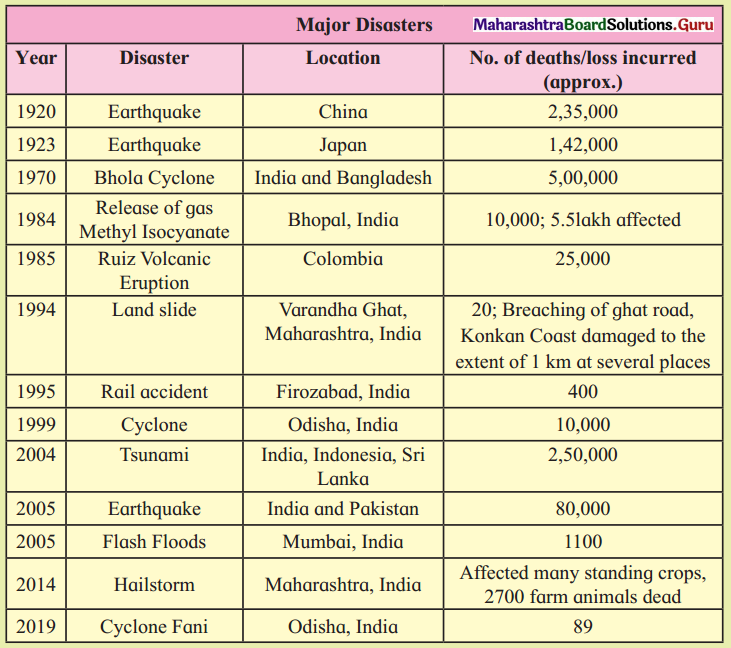
Question 1.
Classify these disasters into natural and man-made disasters.
Answer:
| Natural Disasters | Man-made Disasters |
| Earthquake, Cyclone, Tsunami, Volcanic, eruption, Landslide, Flash Floods, Hailstorm | Landslide, Release of Gas Methyl Isocyanate. Rail Accident. |
Question 2.
Which of these disasters occurred due to climatic conditions?
Answer:
Bhola Cyclone (India and Bangladesh), Cyclone of Odisha, India; Hailstorm in Maharashtra, India; Cyclone Fani in Odisha, India are disasters that occurred due to climatic conditions.
Question 3.
Which of these disasters occurred due to geological causes?
Answer:
Earthquakes (in China, India, Japan, Pakistan) Ruiz Volcanic Eruption (Colombia), Landslide (Varandha Ghats, Maharashtra, India), Tsunami (India, Indonesia, Sri Lanka) occurred due to geological causes.
![]()
Question 4.
Can you relate the location of a disaster with its cause?
Answer:
- Release of gas Methyl Isocyanate during the Bhopal Gas Tragedy in 1984, India, was an Industrial accident caused by human mistake or carelessness.
- Tsunami that affected India, Indonesia, Sri Lanka was caused by an earthquake that occurred in the sea-bed off the Indonesian shore.
Question 5.
Besides the number of deaths, what other losses might be occurring after the disasters?
Answer:
Breaching of ghat road, damage to coastal road in the Konkan, many standing crops were destroyed.
Question 6.
Comparing the cyclones of 1999 and 2019, can you think of the reasons behind the reduction in the number of deaths?
Answer:
In the two decades between 1999 and 2019, the capacity to cope with disasters, manage them, the ability of the people and organisations has undergone a huge improvement.
Question 7.
Which of these disasters can be predicted in advance?
Answer:
Cyclones and Tsunamis can be predicted in advance.
Question 8.
Of those disasters for which prediction can be made, can the people be evacuated from the area?
Answer:
Cyclones can be predicted in advance and the people can be evacuated in advance.
Question 9.
Why do some people get affected by the disaster in specific regions?
Answer:
Some people get affected by disasters in specific areas.
- In case of a cyclone, people in the coastal areas of India are more likely to be affected than those in the interior.
- People living in seismically active regions are prone to earthquakes.
- The poor, the old people and children are more likely to be affected by disasters in the same region.
- Densely populated areas are more likely to be affected than sparsely populated areas.
- Sometimes due to social, economic and political conditions, people are more likely to be affected by disaster in some regions. E.g. poor people are more likely to be affected by disasters.
Can you tell? (Textbook Page No. 99)
If an earthquake occurs with a magnitude of more than 6 in Sahara Desert area which is totally uninhabited by humans and a similar one occurs in Assam, which one would you call a disaster?
Answer:
An earthquake is a hazard but when it occurs in inhabited area, it is called disaster. An earthquake which occurs in Assam can be called a disaster because it is an inhabited area. But an earthquake in Sahara Desert area is not a disaster because it is not inhabited by people.
![]()
Can you do it? (Textbook Page No. 99)
Classify the above components of disaster management into pre-disaster and post-disaster.
Answer:
| Pre-disaster | Post-disaster |
| (i) Preparedness | (i) Evacuation, search and rescue. |
| (ii) Monitoring, Early warning and mitigation | (ii) Providing relief in terms of medical help, basic needs such as food, clothes and shelter. |
| (iii) Reconstruction and rehabilitation. |
Use your brain power! (Textbook Page No. 100)
Question 1.
In 1988, an earthquake of magnitude 6.9 struck Armenia and took 25,000 lives. On the other hand, an earthquake in 1989 in Californ ia of magnitude 7 took only 63 lives. Can you think of the reason behind this difference?
Answer:
Armenia is densely populated whereas California has a lesser population. Hence, the damage and death caused in Armenia is much higher than that in California.
Question 2.
Why is disaster management called a cycle? See the figure given below. (extbook Page No. 101)
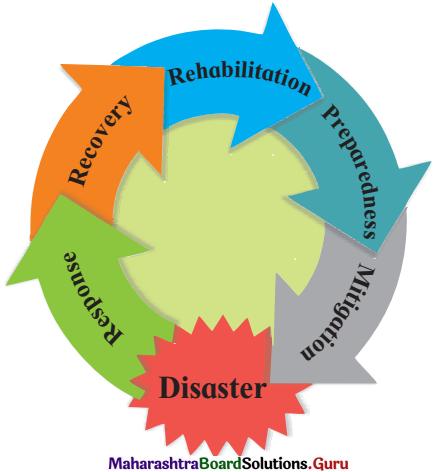
Answer:
The disaster preparedness, mitigation, disaster response, recovery and rehabilitation are the five stages of disaster management which are followed by one after another so it is called disaster management cycle.
![]()
Give it a try. (Textbook Page No. 101)
Given below are a list of measures taken for disaster. Write whether they are pre-disaster or post-disaster and structural or non-structural. Also write the name of the disaster for which they are used. Complete the table.
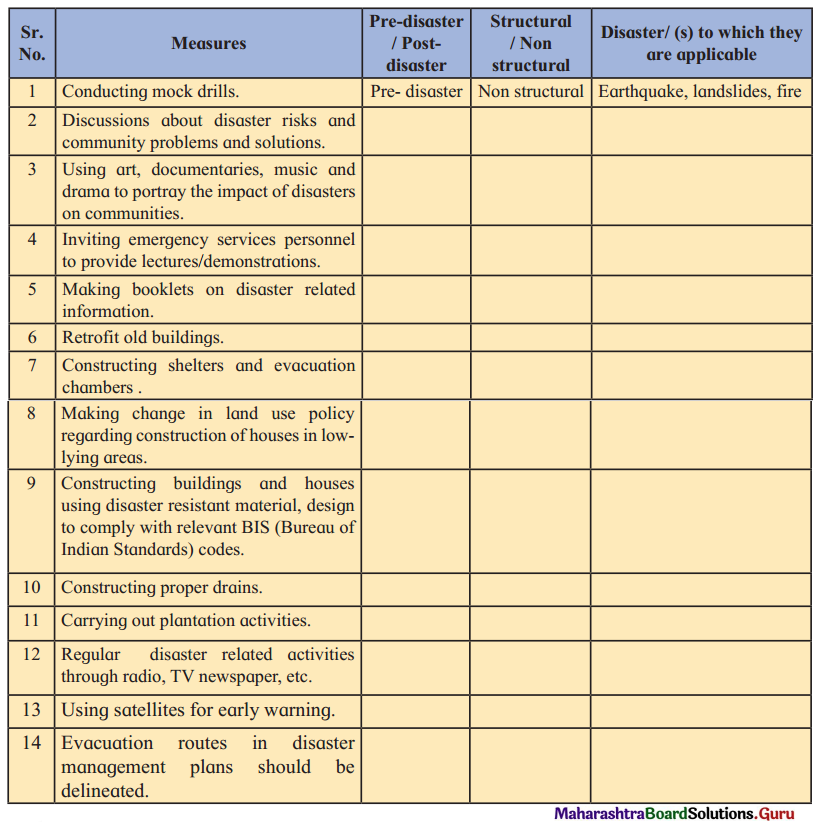
Answer:
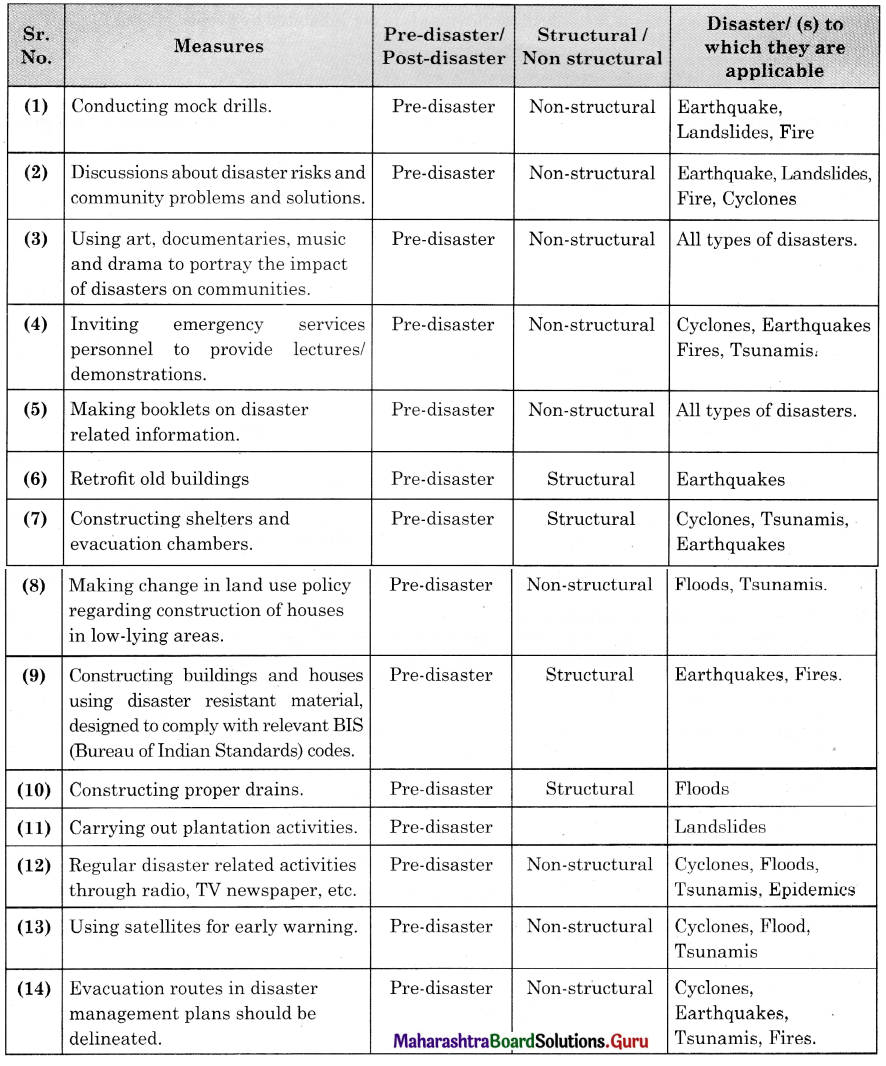
Find out! (Textbook Page No. 102)
Question 1.
Who is responsible for looking after disaster management in our country?
Answer:
- The National Disaster Management Authority (NDMA) with the Prime Minister as the Chairperson heads the Disaster Management in our country.
- Another institute is National Institute of Disaster Management (NIDM).
- Both are located in Delhi.
- At the state level, the State Disaster Management Authority (SDMA) is in charge.
- There is also the National Crisis Management Committee which also functions at the centre with NDMA and NIDM.
- Other agencies are Ministry of Agriculture (disasters such as drought); Military forces and para-military forces like Home Guards.
- ISRO, NRSC (National Remote sensing Centre) also play an important role.
![]()
Question 2.
Find out about the role of the military and paramilitary forces in disaster management of India. (Textbook Page No. 103)
Answer:
Military and paramilitary forces evacuate people from the flood-affected areas. They distribute food packets and clothing in the flood-affected areas. They also help in cleaning debris.
Maharashtra State Board Class 11 Geography Textbook Solutions
- Earth Movements Class 11 Geography Textbook Solutions
- Weathering and Mass Wasting Class 11 Geography Textbook Solutions
- Agents of Erosion Class 11 Geography Textbook Solutions
- Climatic Regions Class 11 Geography Textbook Solutions
- Global Climate Change Class 11 Geography Textbook Solutions
- Ocean Resources Class 11 Geography Textbook Solutions
- Indian Ocean – Relief and Strategic Importance Class 11 Geography Textbook Solutions
- Biomes Class 11 Geography Textbook Solutions
- Disaster Management Class 11 Geography Textbook Solutions

